Business Law Assignment: Partnership, ASIC and Corporate Law
VerifiedAdded on 2023/06/08
|7
|1688
|101
Homework Assignment
AI Summary
This business law assignment addresses key aspects of partnerships and corporate law, specifically within the context of South Australia and the Australian Securities and Investment Commission (ASIC). The assignment begins by identifying the relevant sections of the Partnership Act 1891 required to form a limited partnership in South Australia, followed by a discussion of the roles, rights, and liabilities of both general and limited partners. It then shifts to a scenario involving ASIC's investigation into the conduct of OBC BANKING PTY LTD regarding the provision of financial advice. The assignment analyzes ASIC's powers to investigate corporate matters under the Australian Securities and Investment Commission Act 2001 (Cth), including the power to request documents and intervene in legal proceedings. The solution references specific sections of the Corporations Act 2001 (Cth) and ASIC Act 2001 (Cth) to support its arguments, including provisions related to providing financial advice, directors' duties, and the potential for criminal penalties. The assignment uses the case of Australian Securities and Investments Commission v Cassimatis (No 8) [2016] FCA 1023 to illustrate the application of these legal principles. The assignment provides a comprehensive overview of business law, focusing on partnerships, ASIC investigations, and relevant corporate law principles.
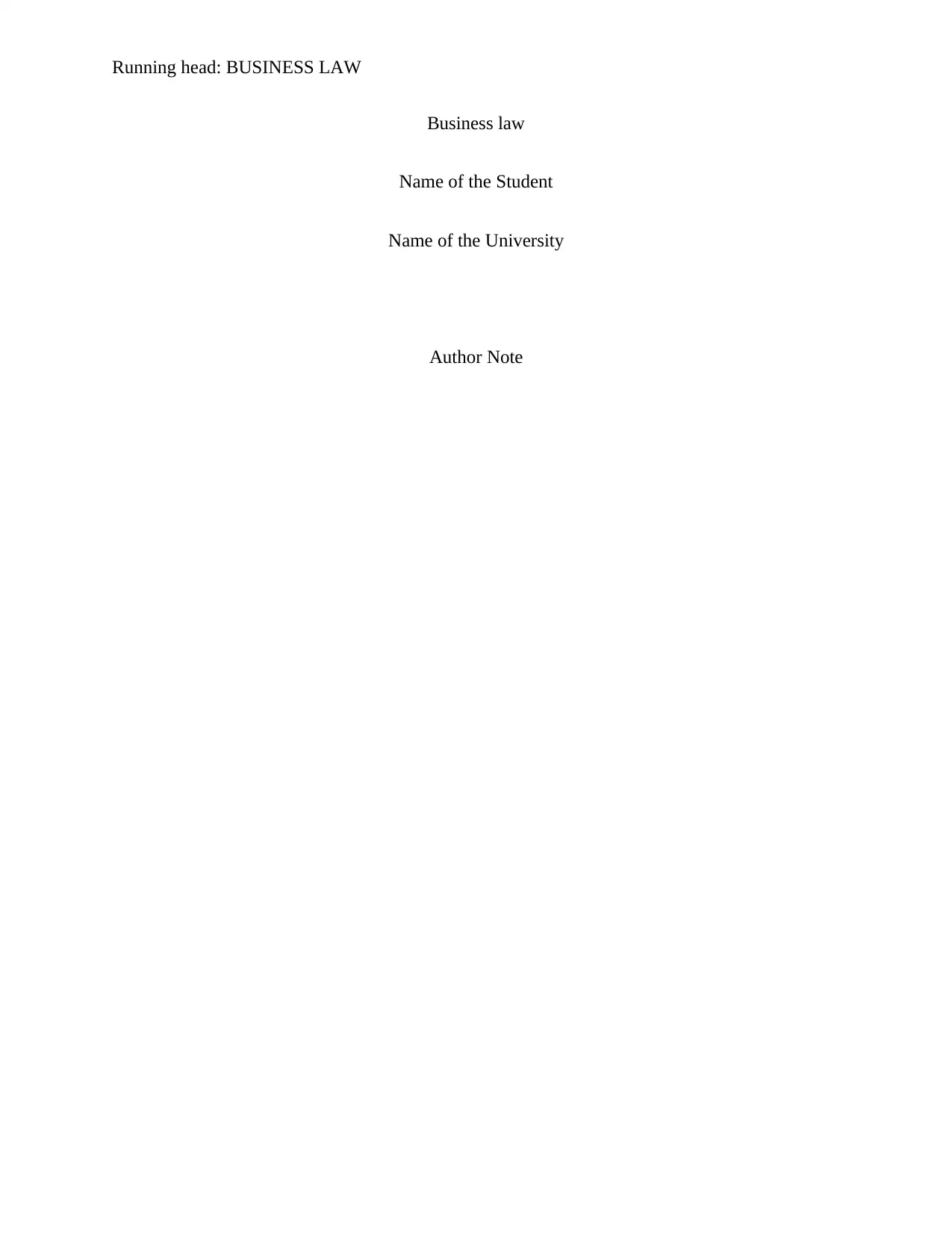
Running head: BUSINESS LAW
Business law
Name of the Student
Name of the University
Author Note
Business law
Name of the Student
Name of the University
Author Note
Paraphrase This Document
Need a fresh take? Get an instant paraphrase of this document with our AI Paraphraser
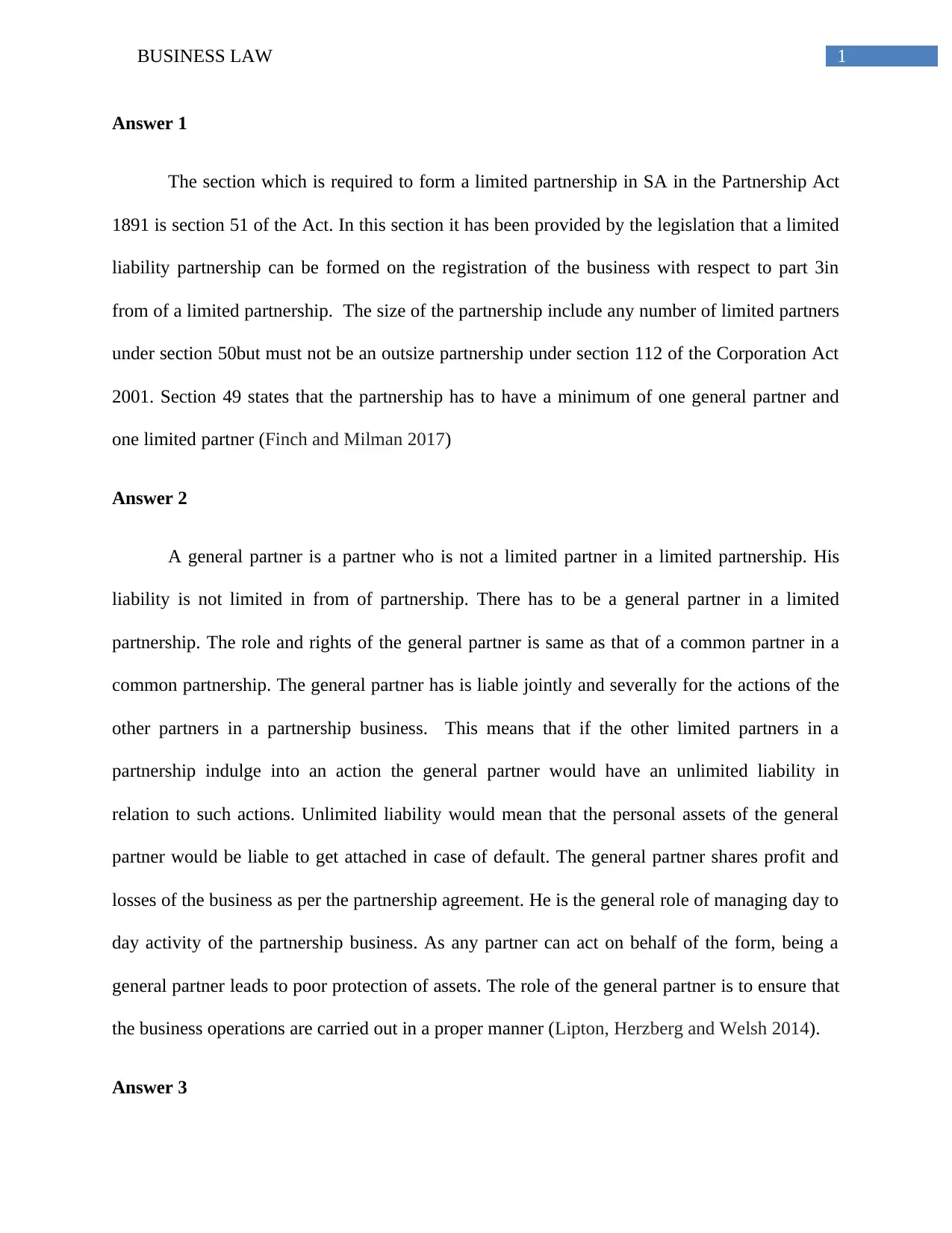
1BUSINESS LAW
Answer 1
The section which is required to form a limited partnership in SA in the Partnership Act
1891 is section 51 of the Act. In this section it has been provided by the legislation that a limited
liability partnership can be formed on the registration of the business with respect to part 3in
from of a limited partnership. The size of the partnership include any number of limited partners
under section 50but must not be an outsize partnership under section 112 of the Corporation Act
2001. Section 49 states that the partnership has to have a minimum of one general partner and
one limited partner (Finch and Milman 2017)
Answer 2
A general partner is a partner who is not a limited partner in a limited partnership. His
liability is not limited in from of partnership. There has to be a general partner in a limited
partnership. The role and rights of the general partner is same as that of a common partner in a
common partnership. The general partner has is liable jointly and severally for the actions of the
other partners in a partnership business. This means that if the other limited partners in a
partnership indulge into an action the general partner would have an unlimited liability in
relation to such actions. Unlimited liability would mean that the personal assets of the general
partner would be liable to get attached in case of default. The general partner shares profit and
losses of the business as per the partnership agreement. He is the general role of managing day to
day activity of the partnership business. As any partner can act on behalf of the form, being a
general partner leads to poor protection of assets. The role of the general partner is to ensure that
the business operations are carried out in a proper manner (Lipton, Herzberg and Welsh 2014).
Answer 3
Answer 1
The section which is required to form a limited partnership in SA in the Partnership Act
1891 is section 51 of the Act. In this section it has been provided by the legislation that a limited
liability partnership can be formed on the registration of the business with respect to part 3in
from of a limited partnership. The size of the partnership include any number of limited partners
under section 50but must not be an outsize partnership under section 112 of the Corporation Act
2001. Section 49 states that the partnership has to have a minimum of one general partner and
one limited partner (Finch and Milman 2017)
Answer 2
A general partner is a partner who is not a limited partner in a limited partnership. His
liability is not limited in from of partnership. There has to be a general partner in a limited
partnership. The role and rights of the general partner is same as that of a common partner in a
common partnership. The general partner has is liable jointly and severally for the actions of the
other partners in a partnership business. This means that if the other limited partners in a
partnership indulge into an action the general partner would have an unlimited liability in
relation to such actions. Unlimited liability would mean that the personal assets of the general
partner would be liable to get attached in case of default. The general partner shares profit and
losses of the business as per the partnership agreement. He is the general role of managing day to
day activity of the partnership business. As any partner can act on behalf of the form, being a
general partner leads to poor protection of assets. The role of the general partner is to ensure that
the business operations are carried out in a proper manner (Lipton, Herzberg and Welsh 2014).
Answer 3
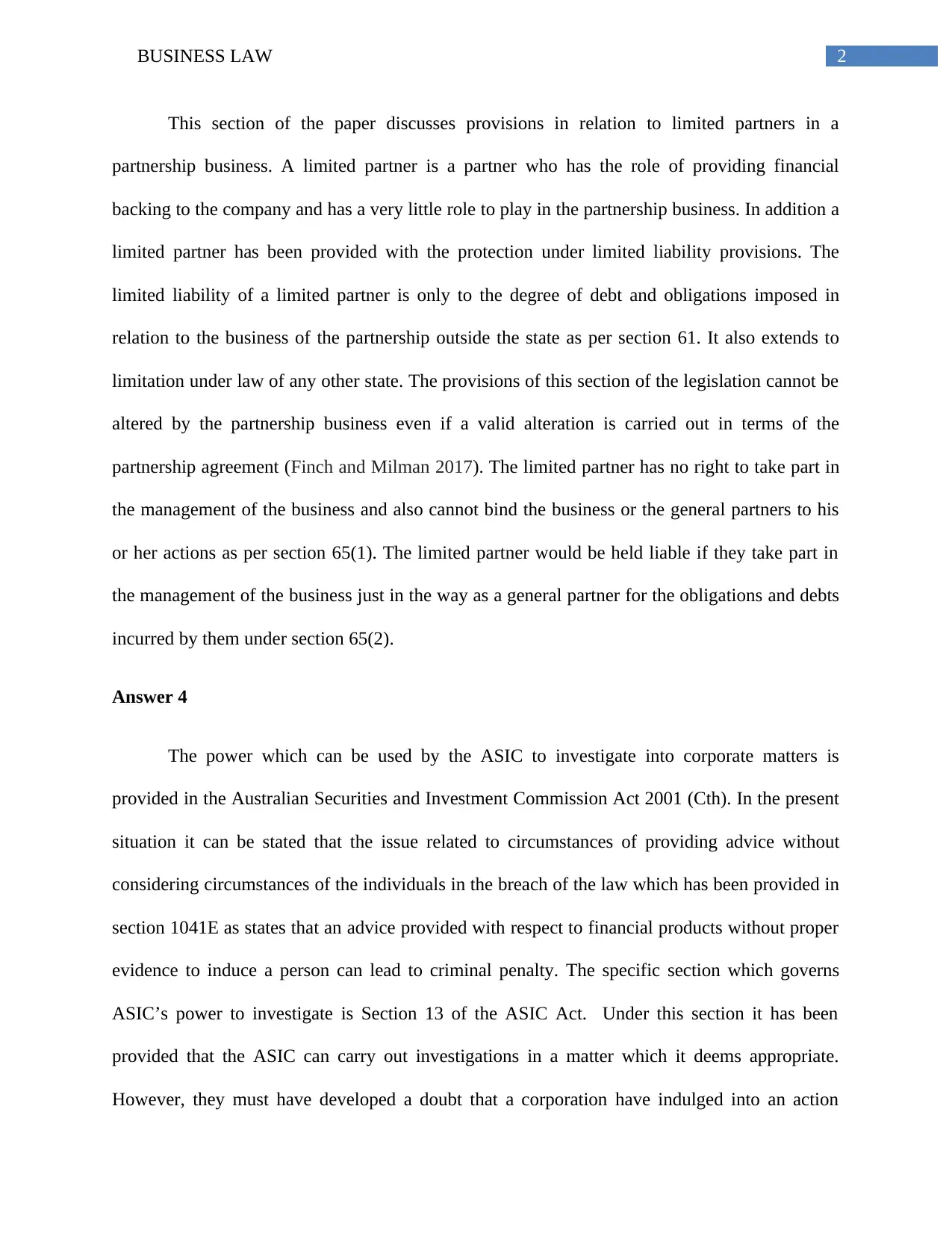
2BUSINESS LAW
This section of the paper discusses provisions in relation to limited partners in a
partnership business. A limited partner is a partner who has the role of providing financial
backing to the company and has a very little role to play in the partnership business. In addition a
limited partner has been provided with the protection under limited liability provisions. The
limited liability of a limited partner is only to the degree of debt and obligations imposed in
relation to the business of the partnership outside the state as per section 61. It also extends to
limitation under law of any other state. The provisions of this section of the legislation cannot be
altered by the partnership business even if a valid alteration is carried out in terms of the
partnership agreement (Finch and Milman 2017). The limited partner has no right to take part in
the management of the business and also cannot bind the business or the general partners to his
or her actions as per section 65(1). The limited partner would be held liable if they take part in
the management of the business just in the way as a general partner for the obligations and debts
incurred by them under section 65(2).
Answer 4
The power which can be used by the ASIC to investigate into corporate matters is
provided in the Australian Securities and Investment Commission Act 2001 (Cth). In the present
situation it can be stated that the issue related to circumstances of providing advice without
considering circumstances of the individuals in the breach of the law which has been provided in
section 1041E as states that an advice provided with respect to financial products without proper
evidence to induce a person can lead to criminal penalty. The specific section which governs
ASIC’s power to investigate is Section 13 of the ASIC Act. Under this section it has been
provided that the ASIC can carry out investigations in a matter which it deems appropriate.
However, they must have developed a doubt that a corporation have indulged into an action
This section of the paper discusses provisions in relation to limited partners in a
partnership business. A limited partner is a partner who has the role of providing financial
backing to the company and has a very little role to play in the partnership business. In addition a
limited partner has been provided with the protection under limited liability provisions. The
limited liability of a limited partner is only to the degree of debt and obligations imposed in
relation to the business of the partnership outside the state as per section 61. It also extends to
limitation under law of any other state. The provisions of this section of the legislation cannot be
altered by the partnership business even if a valid alteration is carried out in terms of the
partnership agreement (Finch and Milman 2017). The limited partner has no right to take part in
the management of the business and also cannot bind the business or the general partners to his
or her actions as per section 65(1). The limited partner would be held liable if they take part in
the management of the business just in the way as a general partner for the obligations and debts
incurred by them under section 65(2).
Answer 4
The power which can be used by the ASIC to investigate into corporate matters is
provided in the Australian Securities and Investment Commission Act 2001 (Cth). In the present
situation it can be stated that the issue related to circumstances of providing advice without
considering circumstances of the individuals in the breach of the law which has been provided in
section 1041E as states that an advice provided with respect to financial products without proper
evidence to induce a person can lead to criminal penalty. The specific section which governs
ASIC’s power to investigate is Section 13 of the ASIC Act. Under this section it has been
provided that the ASIC can carry out investigations in a matter which it deems appropriate.
However, they must have developed a doubt that a corporation have indulged into an action
You're viewing a preview
Unlock full access by subscribing today!
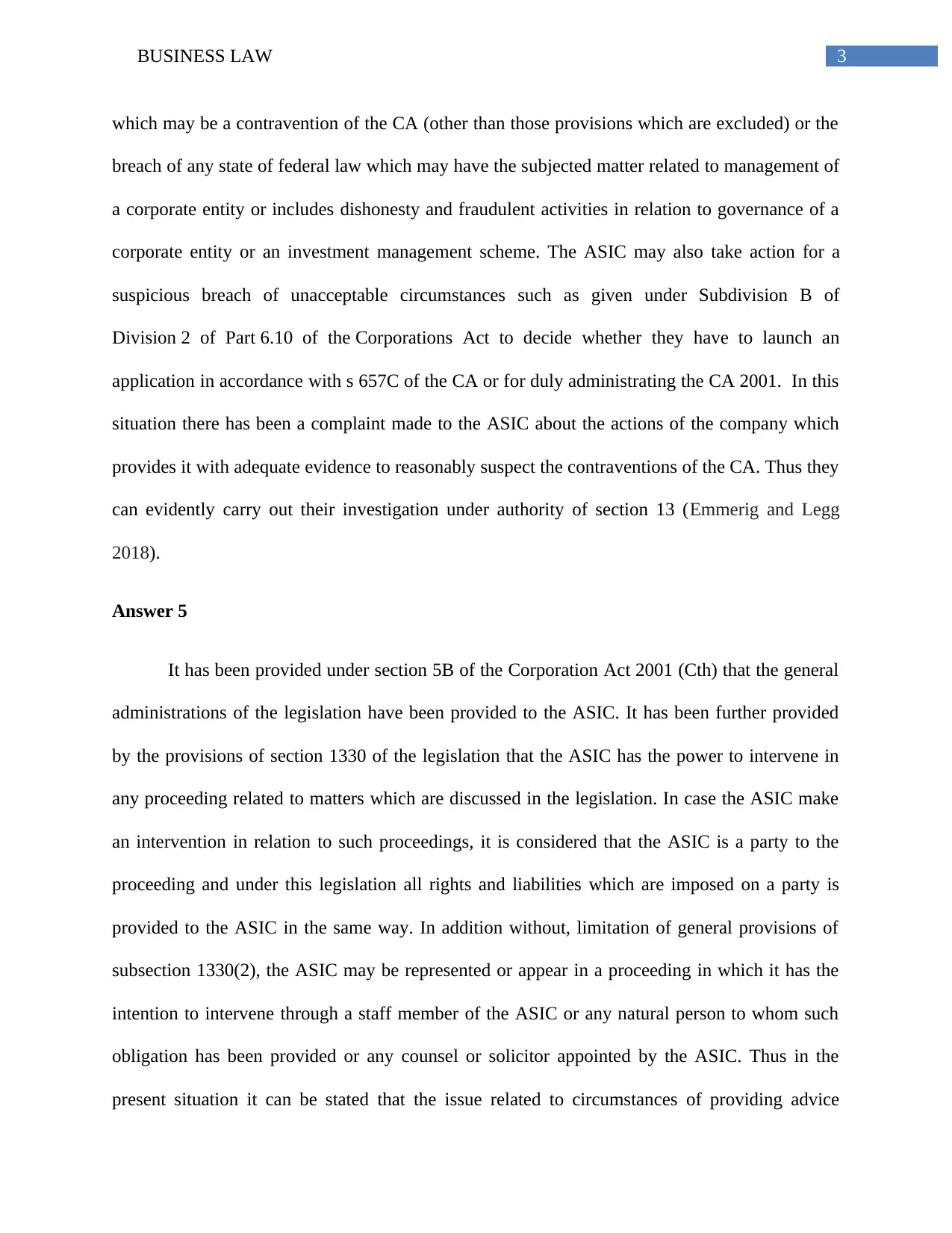
3BUSINESS LAW
which may be a contravention of the CA (other than those provisions which are excluded) or the
breach of any state of federal law which may have the subjected matter related to management of
a corporate entity or includes dishonesty and fraudulent activities in relation to governance of a
corporate entity or an investment management scheme. The ASIC may also take action for a
suspicious breach of unacceptable circumstances such as given under Subdivision B of
Division 2 of Part 6.10 of the Corporations Act to decide whether they have to launch an
application in accordance with s 657C of the CA or for duly administrating the CA 2001. In this
situation there has been a complaint made to the ASIC about the actions of the company which
provides it with adequate evidence to reasonably suspect the contraventions of the CA. Thus they
can evidently carry out their investigation under authority of section 13 (Emmerig and Legg
2018).
Answer 5
It has been provided under section 5B of the Corporation Act 2001 (Cth) that the general
administrations of the legislation have been provided to the ASIC. It has been further provided
by the provisions of section 1330 of the legislation that the ASIC has the power to intervene in
any proceeding related to matters which are discussed in the legislation. In case the ASIC make
an intervention in relation to such proceedings, it is considered that the ASIC is a party to the
proceeding and under this legislation all rights and liabilities which are imposed on a party is
provided to the ASIC in the same way. In addition without, limitation of general provisions of
subsection 1330(2), the ASIC may be represented or appear in a proceeding in which it has the
intention to intervene through a staff member of the ASIC or any natural person to whom such
obligation has been provided or any counsel or solicitor appointed by the ASIC. Thus in the
present situation it can be stated that the issue related to circumstances of providing advice
which may be a contravention of the CA (other than those provisions which are excluded) or the
breach of any state of federal law which may have the subjected matter related to management of
a corporate entity or includes dishonesty and fraudulent activities in relation to governance of a
corporate entity or an investment management scheme. The ASIC may also take action for a
suspicious breach of unacceptable circumstances such as given under Subdivision B of
Division 2 of Part 6.10 of the Corporations Act to decide whether they have to launch an
application in accordance with s 657C of the CA or for duly administrating the CA 2001. In this
situation there has been a complaint made to the ASIC about the actions of the company which
provides it with adequate evidence to reasonably suspect the contraventions of the CA. Thus they
can evidently carry out their investigation under authority of section 13 (Emmerig and Legg
2018).
Answer 5
It has been provided under section 5B of the Corporation Act 2001 (Cth) that the general
administrations of the legislation have been provided to the ASIC. It has been further provided
by the provisions of section 1330 of the legislation that the ASIC has the power to intervene in
any proceeding related to matters which are discussed in the legislation. In case the ASIC make
an intervention in relation to such proceedings, it is considered that the ASIC is a party to the
proceeding and under this legislation all rights and liabilities which are imposed on a party is
provided to the ASIC in the same way. In addition without, limitation of general provisions of
subsection 1330(2), the ASIC may be represented or appear in a proceeding in which it has the
intention to intervene through a staff member of the ASIC or any natural person to whom such
obligation has been provided or any counsel or solicitor appointed by the ASIC. Thus in the
present situation it can be stated that the issue related to circumstances of providing advice
Paraphrase This Document
Need a fresh take? Get an instant paraphrase of this document with our AI Paraphraser
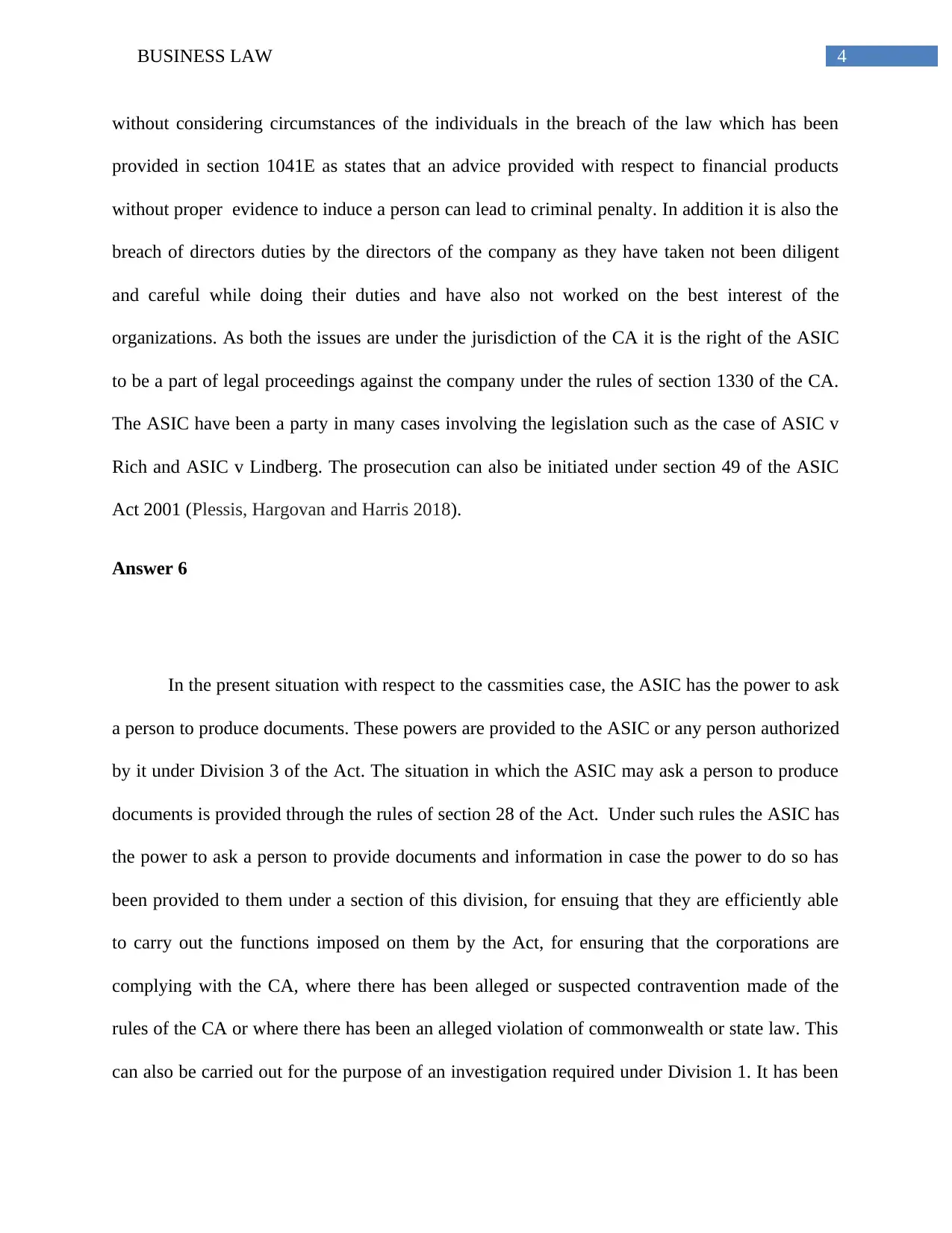
4BUSINESS LAW
without considering circumstances of the individuals in the breach of the law which has been
provided in section 1041E as states that an advice provided with respect to financial products
without proper evidence to induce a person can lead to criminal penalty. In addition it is also the
breach of directors duties by the directors of the company as they have taken not been diligent
and careful while doing their duties and have also not worked on the best interest of the
organizations. As both the issues are under the jurisdiction of the CA it is the right of the ASIC
to be a part of legal proceedings against the company under the rules of section 1330 of the CA.
The ASIC have been a party in many cases involving the legislation such as the case of ASIC v
Rich and ASIC v Lindberg. The prosecution can also be initiated under section 49 of the ASIC
Act 2001 (Plessis, Hargovan and Harris 2018).
Answer 6
In the present situation with respect to the cassmities case, the ASIC has the power to ask
a person to produce documents. These powers are provided to the ASIC or any person authorized
by it under Division 3 of the Act. The situation in which the ASIC may ask a person to produce
documents is provided through the rules of section 28 of the Act. Under such rules the ASIC has
the power to ask a person to provide documents and information in case the power to do so has
been provided to them under a section of this division, for ensuing that they are efficiently able
to carry out the functions imposed on them by the Act, for ensuring that the corporations are
complying with the CA, where there has been alleged or suspected contravention made of the
rules of the CA or where there has been an alleged violation of commonwealth or state law. This
can also be carried out for the purpose of an investigation required under Division 1. It has been
without considering circumstances of the individuals in the breach of the law which has been
provided in section 1041E as states that an advice provided with respect to financial products
without proper evidence to induce a person can lead to criminal penalty. In addition it is also the
breach of directors duties by the directors of the company as they have taken not been diligent
and careful while doing their duties and have also not worked on the best interest of the
organizations. As both the issues are under the jurisdiction of the CA it is the right of the ASIC
to be a part of legal proceedings against the company under the rules of section 1330 of the CA.
The ASIC have been a party in many cases involving the legislation such as the case of ASIC v
Rich and ASIC v Lindberg. The prosecution can also be initiated under section 49 of the ASIC
Act 2001 (Plessis, Hargovan and Harris 2018).
Answer 6
In the present situation with respect to the cassmities case, the ASIC has the power to ask
a person to produce documents. These powers are provided to the ASIC or any person authorized
by it under Division 3 of the Act. The situation in which the ASIC may ask a person to produce
documents is provided through the rules of section 28 of the Act. Under such rules the ASIC has
the power to ask a person to provide documents and information in case the power to do so has
been provided to them under a section of this division, for ensuing that they are efficiently able
to carry out the functions imposed on them by the Act, for ensuring that the corporations are
complying with the CA, where there has been alleged or suspected contravention made of the
rules of the CA or where there has been an alleged violation of commonwealth or state law. This
can also be carried out for the purpose of an investigation required under Division 1. It has been
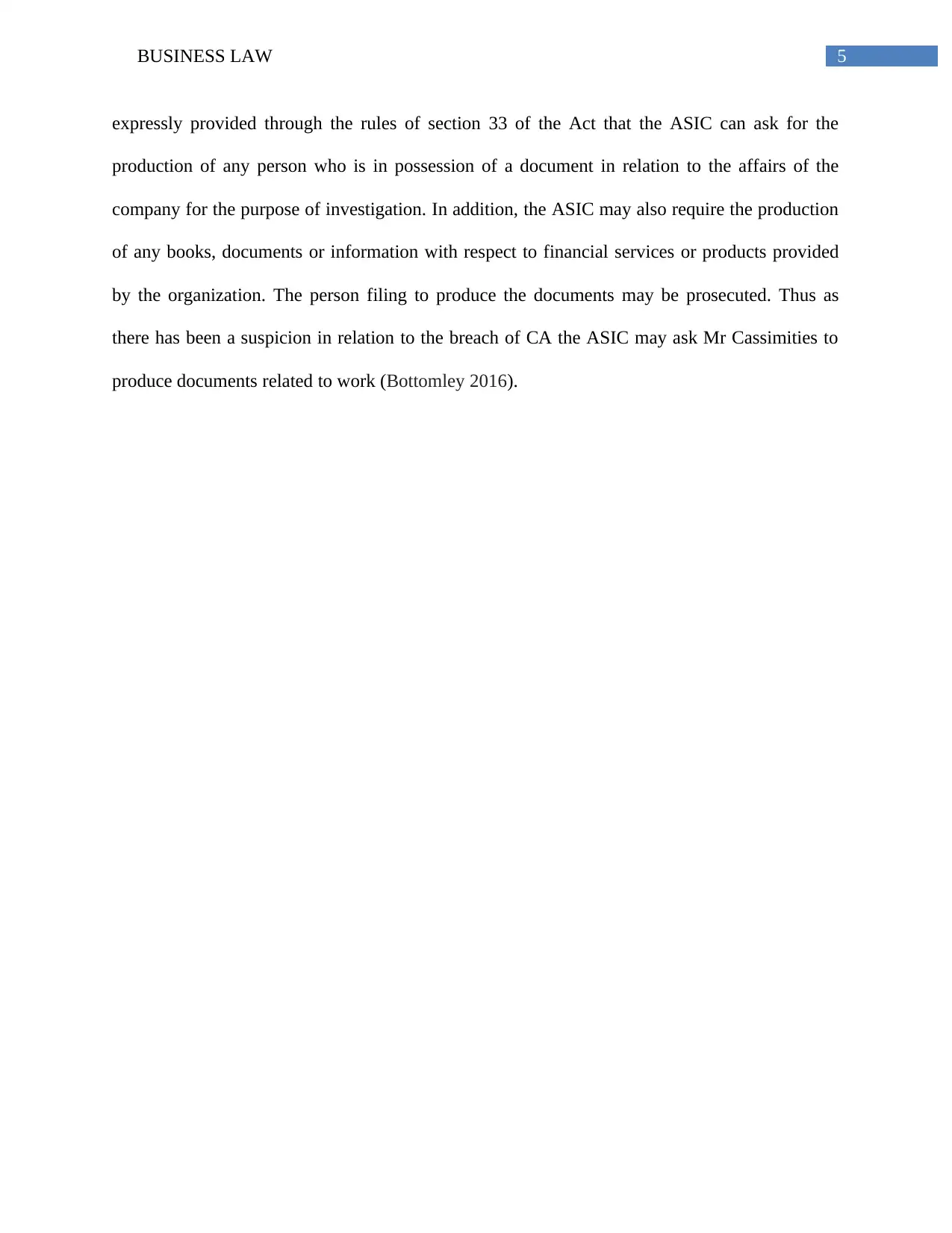
5BUSINESS LAW
expressly provided through the rules of section 33 of the Act that the ASIC can ask for the
production of any person who is in possession of a document in relation to the affairs of the
company for the purpose of investigation. In addition, the ASIC may also require the production
of any books, documents or information with respect to financial services or products provided
by the organization. The person filing to produce the documents may be prosecuted. Thus as
there has been a suspicion in relation to the breach of CA the ASIC may ask Mr Cassimities to
produce documents related to work (Bottomley 2016).
expressly provided through the rules of section 33 of the Act that the ASIC can ask for the
production of any person who is in possession of a document in relation to the affairs of the
company for the purpose of investigation. In addition, the ASIC may also require the production
of any books, documents or information with respect to financial services or products provided
by the organization. The person filing to produce the documents may be prosecuted. Thus as
there has been a suspicion in relation to the breach of CA the ASIC may ask Mr Cassimities to
produce documents related to work (Bottomley 2016).
You're viewing a preview
Unlock full access by subscribing today!
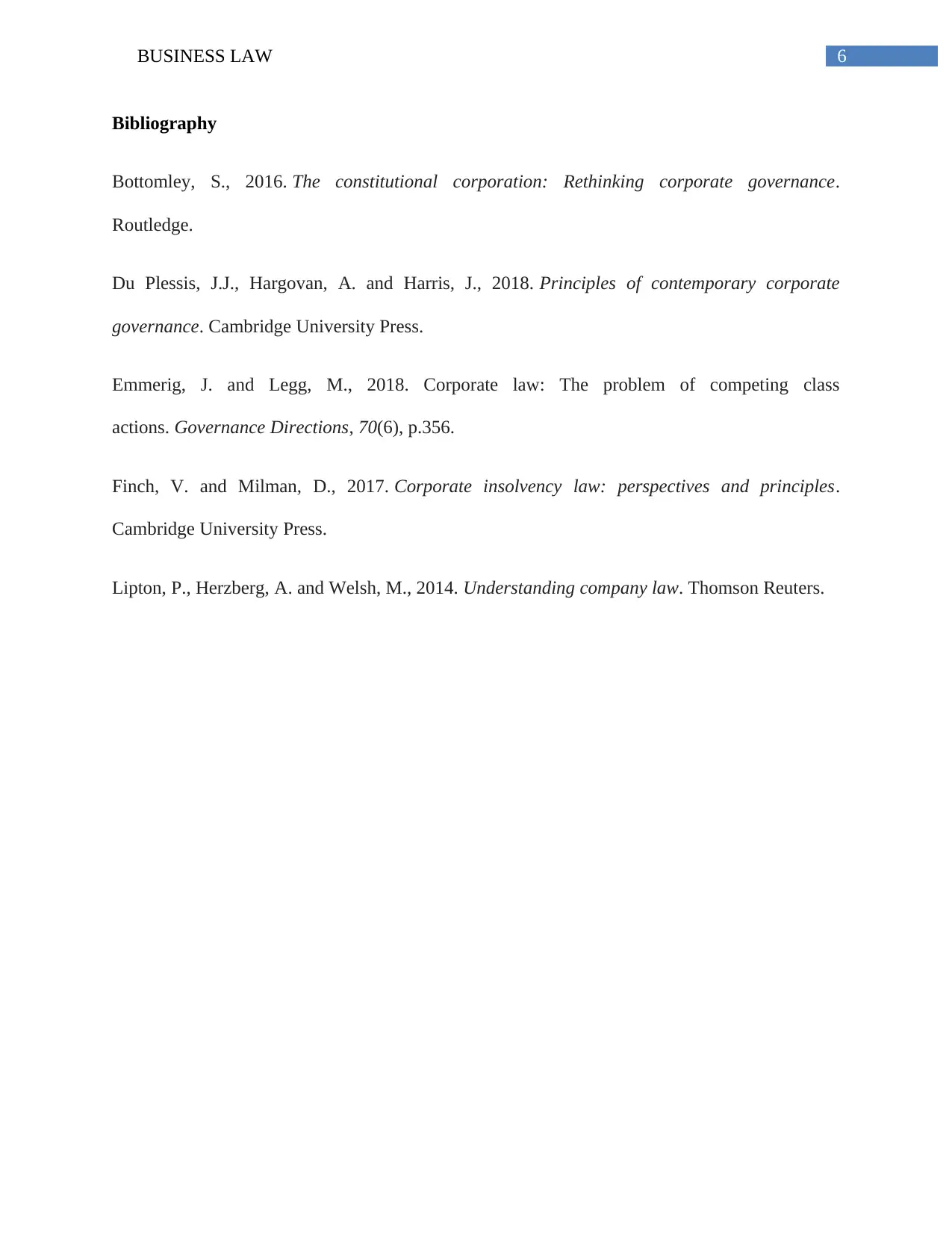
6BUSINESS LAW
Bibliography
Bottomley, S., 2016. The constitutional corporation: Rethinking corporate governance.
Routledge.
Du Plessis, J.J., Hargovan, A. and Harris, J., 2018. Principles of contemporary corporate
governance. Cambridge University Press.
Emmerig, J. and Legg, M., 2018. Corporate law: The problem of competing class
actions. Governance Directions, 70(6), p.356.
Finch, V. and Milman, D., 2017. Corporate insolvency law: perspectives and principles.
Cambridge University Press.
Lipton, P., Herzberg, A. and Welsh, M., 2014. Understanding company law. Thomson Reuters.
Bibliography
Bottomley, S., 2016. The constitutional corporation: Rethinking corporate governance.
Routledge.
Du Plessis, J.J., Hargovan, A. and Harris, J., 2018. Principles of contemporary corporate
governance. Cambridge University Press.
Emmerig, J. and Legg, M., 2018. Corporate law: The problem of competing class
actions. Governance Directions, 70(6), p.356.
Finch, V. and Milman, D., 2017. Corporate insolvency law: perspectives and principles.
Cambridge University Press.
Lipton, P., Herzberg, A. and Welsh, M., 2014. Understanding company law. Thomson Reuters.
1 out of 7
Related Documents
Your All-in-One AI-Powered Toolkit for Academic Success.
+13062052269
info@desklib.com
Available 24*7 on WhatsApp / Email
![[object Object]](/_next/static/media/star-bottom.7253800d.svg)
Unlock your academic potential
© 2024 | Zucol Services PVT LTD | All rights reserved.




